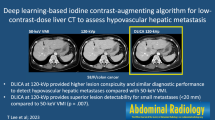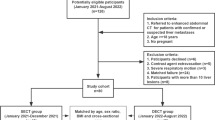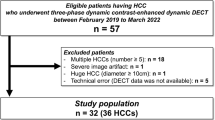Abstract
Objectives
To evaluate the diagnostic value of deep learning model (DLM) reconstructed dual-energy CT (DECT) low-keV virtual monoenergetic imaging (VMI) for assessing hypoenhancing hepatic metastases.
Methods
This retrospective study included 131 patients who underwent contrast-enhanced DECT (80-kVp and 150-kVp with a tin filter) in the portal venous phase for hepatic metastasis surveillance. Linearly blended images simulating 100-kVp images (100-kVp), standard 40-keV VMI images (40-keV VMI), and post-processed 40-keV VMI using a vendor-agnostic DLM (i.e., DLM 40-keV VMI) were reconstructed. Lesion conspicuity and diagnostic acceptability were assessed by three independent reviewers and compared using the Wilcoxon signed-rank test. The contrast-to-noise ratios (CNRs) were also measured placing ROIs in metastatic lesions and liver parenchyma. The detection performance of hepatic metastases was assessed by using a jackknife alternative free-response ROC method. The consensus by two independent radiologists was used as the reference standard.
Results
DLM 40-keV VMI, compared to 40-keV VMI and 100-kVp, showed a higher lesion-to-liver CNR (8.25 ± 3.23 vs. 6.05 ± 2.38 vs. 5.99 ± 2.00), better lesion conspicuity (4.3 (4.0–4.7) vs. 3.7 (3.7–4.0) vs. 3.7 (3.3–4.0)), and better diagnostic acceptability (4.3 (4.0–4.3) vs. 3.0 (2.7–3.3) vs. 4.0 (4.0–4.3)) (p < 0.001 for all). For lesion detection (246 hepatic metastases in 68 patients), the figure of merit was significantly higher with DLM 40-keV VMI than with 40-keV VMI (0.852 vs. 0.822, p = 0.012), whereas no significant difference existed between DLM 40-keV VMI and 100-kVp (0.852 vs. 0.842, p = 0.31).
Conclusions
DLM 40-keV VMI provided better image quality and comparable diagnostic performance for detecting hypoenhancing hepatic metastases compared to linearly blended images.
Key Points
• DLM 40-keV VMI provides a superior image quality compared with 40-keV or 100-kVp for assessing hypoenhancing hepatic metastasis.
• DLM 40-keV VMI has the highest CNR and lesion conspicuity score for hypoenhancing hepatic metastasis due to noise reduction and structural preservation.
• DLM 40-keV VMI provides higher lesion detectability than standard 40-keV VMI (p = 0.012).




Similar content being viewed by others
Abbreviations
- ADMIRE:
-
Advanced modeled iterative reconstruction
- CNR:
-
Contrast-to-noise ratio
- DLM:
-
Deep learning model
- ERS:
-
Edge rise slope
- FOM:
-
Figure of merit
- JAFROC:
-
Jackknife alternative free-response receiver operating characteristic
- SNR:
-
Signal-to-noise ratio
- VMI:
-
Virtual monoenergetic imaging
References
Matos AP, Altun E, Ramalho M, Velloni F, AlObaidy M, Semelka RC (2015) An overview of imaging techniques for liver metastases management. Expert Rev Gastroenterol Hepatol 9:1561–1576
Schima W, Kulinna C, Langenberger H, Ba-Ssalamah A (2005) Liver metastases of colorectal cancer: US, CT or MR? Cancer Imaging 5 Spec No A:S149–156
Sica GT, Ji H, Ros PR (2000) CT and MR imaging of hepatic metastases. AJR Am J Roentgenol 174:691–698
Granata V, Fusco R, de Lutio di Castelguidone E et al (2019) Diagnostic performance of gadoxetic acid-enhanced liver MRI versus multidetector CT in the assessment of colorectal liver metastases compared to hepatic resection. BMC Gastroenterol 19:129
Motosugi U, Ichikawa T, Morisaka H et al (2011) Detection of pancreatic carcinoma and liver metastases with gadoxetic acid-enhanced MR imaging: comparison with contrast-enhanced multi-detector row CT. Radiology 260:446–453
Niekel MC, Bipat S, Stoker J (2010) Diagnostic imaging of colorectal liver metastases with CT, MR imaging, FDG PET, and/or FDG PET/CT: a meta-analysis of prospective studies including patients who have not previously undergone treatment. Radiology 257:674–684
Tao S, Rajendran K, Zhou W, Fletcher JG, McCollough CH, Leng S (2019) Improving iodine contrast to noise ratio using virtual monoenergetic imaging and prior-knowledge-aware iterative denoising (mono-PKAID). Phys Med Biol 64:105014
Schindera ST, Hareter LF, Raible S et al (2012) Effect of tumor size and tumor-to-liver contrast of hypovascular liver tumors on the diagnostic performance of hepatic CT imaging. Invest Radiol 47:197–201
Lv P, Zhou Z, Liu J et al (2019) Can virtual monochromatic images from dual-energy CT replace low-kVp images for abdominal contrast-enhanced CT in small- and medium-sized patients? Eur Radiol 29:2878–2889
Yu MH, Lee JM, Yoon JH et al (2013) Low tube voltage intermediate tube current liver MDCT: sinogram-affirmed iterative reconstruction algorithm for detection of hypervascular hepatocellular carcinoma. AJR Am J Roentgenol 201:23–32
McCollough CH, Leng S, Yu L, Fletcher JG (2015) Dual- and multi-energy CT: principles, technical approaches, and clinical applications. Radiology 276:637–653
Grant KL, Flohr TG, Krauss B, Sedlmair M, Thomas C, Schmidt B (2014) Assessment of an advanced image-based technique to calculate virtual monoenergetic computed tomographic images from a dual-energy examination to improve contrast-to-noise ratio in examinations using iodinated contrast media. Invest Radiol 49:586–592
Kalisz K, Rassouli N, Dhanantwari A, Jordan D, Rajiah P (2018) Noise characteristics of virtual monoenergetic images from a novel detector-based spectral CT scanner. Eur J Radiol 98:118–125
Li Z, Yu L, Trzasko JD et al (2014) Adaptive nonlocal means filtering based on local noise level for CT denoising. Med Phys 41:011908
Hanson GJ, Michalak GJ, Childs R et al (2018) Low kV versus dual-energy virtual monoenergetic CT imaging for proven liver lesions: what are the advantages and trade-offs in conspicuity and image quality? A pilot study. Abdom Radiol (NY) 43:1404–1412
Akagi M, Nakamura Y, Higaki T et al (2019) Deep learning reconstruction improves image quality of abdominal ultra-high-resolution CT. Eur Radiol 29:6163–6171
Higaki T, Nakamura Y, Zhou J et al (2020) Deep learning reconstruction at CT: phantom study of the image characteristics. Acad Radiol 27:82–87
Nakamura Y, Higaki T, Tatsugami F et al (2019) Deep learning-based CT image reconstruction: initial evaluation targeting hypovascular hepatic metastases. Radiol Artif Intell 1:e180011
Gong H, Marsh JF, D'Souza KN et al (2021) Deep-learning-based direct synthesis of low-energy virtual monoenergetic images with multi-energy CT. J Med Imaging (Bellingham) 8:052104
Noda Y, Kawai N, Nagata S et al (2022) Deep learning image reconstruction algorithm for pancreatic protocol dual-energy computed tomography: image quality and quantification of iodine concentration. Eur Radiol 32:384–394
Lee S, Choi YH, Cho YJ et al (2021) Noise reduction approach in pediatric abdominal CT combining deep learning and dual-energy technique. Eur Radiol 31:2218–2226
Sica GT (2006) Bias in research Studies. Radiology 238:780–789
Lenga L, Lange M, Arendt CT et al (2021) Can dual-energy CT-based virtual monoenergetic imaging improve the assessment of hypodense liver metastases in patients with hepatic steatosis? Acad Radiol 28:769–777
Nagayama Y, Iyama A, Oda S et al (2019) Dual-layer dual-energy computed tomography for the assessment of hypovascular hepatic metastases: impact of closing k-edge on image quality and lesion detectability. Eur Radiol 29:2837–2847
Ahn C, Heo C, Kim JH (2019) Combined low-dose simulation and deep learning for CT denoising: application in ultra-low-dose chest CT. Proc SPIE 11050. https://doi.org/10.1117/12.2521539
Ahn C, Jin H, Heo C, Kim JH (2019) Combined low-dose simulation and deep learning for CT denoising: application of ultra-low-dose cardiac CTA. Proc SPIE 10948. https://doi.org/10.1117/12.2513144
Park HJ, Lee JM, Park SB, Lee JB, Jeong YK, Yoon JH (2016) Comparison of knowledge-based iterative model reconstruction and hybrid reconstruction techniques for liver CT evaluation of hypervascular hepatocellular carcinoma. J Comput Assist Tomogr 40:863–871
Börjesson S, Håkansson M, Båth M et al (2005) A software tool for increased efficiency in observer performance studies in radiology. Radiat Prot Dosimetry 114:45–52
Svalkvist A, Svensson S, Håkansson M, Båth M, Månsson LG (2016) Viewdex: A status report. Radiat Prot Dosimetry 169:38–45
Lee KH, Lee JM, Park JH et al (2013) MR imaging in patients with suspected liver metastases: value of liver-specific contrast agent gadoxetic acid. Korean J Radiol 14:894–904
Robinson E, Babb J, Chandarana H, Macari M (2010) Dual source dual energy MDCT: comparison of 80 kVp and weighted average 120 kVp data for conspicuity of hypo-vascular liver metastases. Invest Radiol 45:413–418
Yamada Y, Jinzaki M, Tanami Y, Abe T, Kuribayashi S (2012) Virtual monochromatic spectral imaging for the evaluation of hypovascular hepatic metastases: the optimal monochromatic level with fast kilovoltage switching dual-energy computed tomography. Invest Radiol 47:292–298
Cronbach LJ (1951) Coefficient alpha and the internal structure of tests. Psychometrika 16:297–334
Lance CE, Butts MM, Michels LC (2006) The sources of four commonly reported cutoff criteria: what did they really say? Organ Res Methods 9:202–220
Chakraborty DP (2006) Analysis of location specific observer performance data: validated extensions of the jackknife free-response (JAFROC) method. Acad Radiol 13:1187–1193
Vikgren J, Zachrisson S, Svalkvist A et al (2008) Comparison of chest tomosynthesis and chest radiography for detection of pulmonary nodules: human observer study of clinical cases. Radiology 249:1034–1041
Zheng B, Chakraborty DP, Rockette HE, Maitz GS, Gur D (2005) A comparison of two data analyses from two observer performance studies using JackKnife ROC and JAFROC. Med Phys 32:1031–1034
Chakraborty DP, Berbaum KS (2004) Observer studies involving detection and localization: modeling, analysis, and validation. Med Phys 31:2313–2330
Meltzer C, Vikgren J, Bergman B et al (2018) Detection and characterization of solid pulmonary nodules at digital chest tomosynthesis: data from a cohort of the pilot Swedish cardiopulmonary BioImage study. Radiology 287:1018–1027
Stock C, Hielscher T (2018) DTComPair: comparison of binary diagnostic tests in a paired study design. R package version 1.0.3, 2014
Genders TSS, Spronk S, Stijnen T, Steyerberg EW, Lesaffre E, Hunink MGM (2012) Methods for calculating sensitivity and specificity of clustered data: a tutorial. Radiology 265:910–916
De Cecco CN, Caruso D, Schoepf UJ et al (2018) A noise-optimized virtual monoenergetic reconstruction algorithm improves the diagnostic accuracy of late hepatic arterial phase dual-energy CT for the detection of hypervascular liver lesions. Eur Radiol 28:3393–3404
Lenga L, Czwikla R, Wichmann JL et al (2018) Dual-energy CT in patients with colorectal cancer: improved assessment of hypoattenuating liver metastases using noise-optimized virtual monoenergetic imaging. Eur J Radiol 106:184–191
Acknowledgements
This work was supported by the Korea Medical Device Development Fund grant funded by the Korea government (the Ministry of Science and ICT, the Ministry of Trade, Industry and Energy, the Ministry of Health & Welfare, the Ministry of Food and Drug Safety) (Project Number: KMDF_PR_20200901_0226, 9991006891).
Funding
The authors state that this work has not received any funding.
Author information
Authors and Affiliations
Corresponding author
Ethics declarations
Guarantor
The scientific guarantor of this publication is Jeong Min Lee.
Conflict of interest
One author (J.H.K.) is CO-CEO & CTO of ClariPI, but did not have control over any of the data or information submitted for publication. The other authors of this manuscript declare no relationships with any companies whose products or services may be related to the subject matter of the article.
Statistics and biometry
No complex statistical methods were necessary for this paper.
Informed consent
Written informed consent was waived by the institutional review board.
Ethical approval
Institutional review board approval was obtained.
Methodology
• retrospective
• observational
• performed at one institution
Additional information
Publisher’s note
Springer Nature remains neutral with regard to jurisdictional claims in published maps and institutional affiliations.
Supplementary Information
ESM 1
(DOCX 1655 kb)
Rights and permissions
About this article
Cite this article
Lee, T., Lee, J.M., Yoon, J.H. et al. Deep learning–based image reconstruction of 40-keV virtual monoenergetic images of dual-energy CT for the assessment of hypoenhancing hepatic metastasis. Eur Radiol 32, 6407–6417 (2022). https://doi.org/10.1007/s00330-022-08728-0
Received:
Revised:
Accepted:
Published:
Issue Date:
DOI: https://doi.org/10.1007/s00330-022-08728-0




